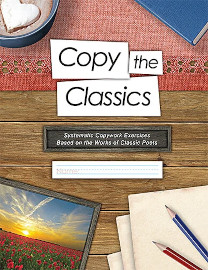Copy the Classics: Systematic Copywork Exercises Based on the Works of Classic Poets provides children in about first through third grades with copywork practice (manuscript rather than cursive) in this beautifully formatted, full-color book. While it was created for use alongside Heart of Dakota’s Beyond Little Hearts for His Glory, it can be used as a standalone book.
The book has 34 units, each based on a poem or rhyme from the public domain by authors such as Sara Coleridge, Robert Louis Stevenson, and William Wordsworth. Among them are religious poems, such as “Maker of Heaven and Earth” by Cecil Frances Alexander, and patriotic poems, such as “The Flag Goes By” by Henry H. Bennett.
Each unit includes an image of a painting that mirrors the theme of the poem or rhyme. The paintings might be used for observation and discussion in a Charlotte-Mason fashion.
The spiral-bound Copy the Classics book lies flat for ease of writing. The type throughout is a clean, sans-serif font that is easy to read and presents letters such as a and g the way students will usually print them.
The book has several features that gradually advance the difficulty of the work. Lessons begin with half-inch lines, with a dotted line through the middle to assist beginning handwriters. The lines gradually narrow to 3/8 inch in height, then 5/16. Space is included between the lines until Unit 25 where the spacing is dropped. The dotted line through the middle of the lines is provided until Unit 31.
Handwriting
Each poem or rhyme is presented on a full page, with copywork beginning on the next page, usually continuing for one or more pages depending upon the length of the poem and the spacing of the lines. For the first nine units, each copywork line is followed immediately by the blank line on which the student will write. With Units 10 through 21, two or three lines of the poems or rhymes are presented with student lines beneath them. At this point, the first word or two of each line is preprinted for students in a light font so they know where to begin each copywork line. Units 22 through 26 increase the number of lines to be copied to four. The rest of the units transition students to copying directly from the poems rather than from lines repeated immediately above where they write. For these last units, students copy the complete poems, and all copywork is done on the page facing the poem. I’m impressed with the care taken to gradually develop handwriting skills.
Each unit might take from one to several sessions to complete, depending upon each child’s ability. Copywork sessions should take no longer than 15 minutes at a time, although you might spend more time if you are discussing the poems and paintings.
Other Language Arts
Copywork can also be useful for spelling, grammar, capitalization, punctuation, and vocabulary since students become familiar with proper spelling and usage as they copy. Of course, parents can take time to instruct children about unfamiliar words and forms if they wish. There are no instructions for parents in this regard, but I think it’s worth taking time to add explanations for some of the new elements students encounter.
As you would expect, the poems include various types of punctuation (e.g., exclamation points and quotation marks) and use words like primrose, winnowing, and perilous that might be unfamiliar to young students. Also, some poems include language that might need explaining for children to grasp the meaning, such as “On stormy nights when wild north-westers rave…” (“Where Lies the Land?” by Arthur Hugh Clough in Unit 7).
While copywork provides the opportunity for extended work in language arts, some children will happily do the copywork without any desire for further explanation. So it’s up to parents how they use it.
Summary
Copy the Classics is such a beautiful book that I expect students will enjoy doing copywork much more than if they were copying onto plain paper or less attractive pages. And the poems, rhymes, and paintings offer parents the opportunity to expand the study into poetry, art, and other areas of language arts.










